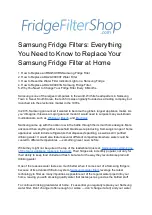
SPRINKLER GENERAL CARE,
INSTALLATION, AND
MAINTENANCE GUIDE
TECHNICAL DATA
Page 2 of 4
Form No. F_080614 18.10.11 Rev 16.1.P65
The Viking Corporation, 210 N Industrial Park Drive, Hastings MI 49058
Telephone: 269-945-9501 Technical Services: 877-384-5464 Fax: 269-818-1680 Email: [email protected]
Visit the Viking website for the latest edition of this technical data page.
Before installation, be sure to have the appropriate sprinkler model and style, with the correct K-Factor, temperature rating, and
response characteristics. Sprinklers must be installed after the piping is in place to prevent mechanical damage. Keep sprinklers
with protective caps or bulb shields contained within the caps or shields during installation and testing, and any time the sprinkler
is shipped or handled.
1a. For frame-style sprinklers, install escutcheon (if used), which is designed to thread onto the external threads of the sprinkler.
Refer to the appropriate sprinkler data page to determine approved escutcheons for use with specific sprinkler models.
1b. For flush and concealed style sprinklers: Cut the sprinkler nipple so that the ½” or 3/4” (15 mm or 20 mm)* NPT outlet of the
reducing coupling is at the desired location, and centered in the opening* in the ceiling or wall.
*Size depends on the sprinkler model used. Refer to the sprinkler technical data page.
2. Apply a small amount of pipe-joint compound or tape to the external threads of the sprinkler only, taking care not to allow a
build-up of compound in the sprinkler inlet.
NOTE:
Sprinklers with protective caps or bulb shields must have the caps or shields
kept on them when applying pipe-joint compound or tape.
Exception: For domed concealed sprinklers, remove the protective
cap for installation, and then place it back on the sprinkler temporarily..
3. Refer to the appropriate sprinkler technical data page to determine the correct sprinkler wrench for the model of sprinkler used.
DO NOT use the deflector or fusible element to start or thread the sprinkler into a fitting.
a. Install the sprinkler onto the piping using the special sprinkler wrench only, taking care not to over-tighten or damage the
sprinkler.
b. For flush and concealed style sprinklers: the internal diameter of the special sprinkler installation wrench is designed for use
with the sprinkler contained in the protective cap.
Exception: For domed concealed sprinklers, remove the protective cap for
installation, and then place it back on the sprinkler temporarily.
Thread the flush or concealed sprinkler into the ½” or 3/4”
(15 mm or 20 mm)* NPT outlet of the coupling by turning it clockwise with the special sprinkler wrench.
*Thread size depends
on the particular sprinkler model used. Refer to the sprinkler technical data page.
C. Installation Instructions - Dry Sprinklers
WARNING:
Viking dry sprinklers are to be installed in the 1” outlet (for dry and preaction systems), or run of malleable, ductile
iron, or Nibco CPVC* threaded tee fittings (for wet systems) that meet the dimensional requirements of ANSI B16.3 (Class 150),
or cast iron threaded tee fittings that meet the dimensional requirements of ANSI B16.4 (Class 125), even at branch line ends. The
threaded end of the dry sprinkler is designed to allow the seal to penetrate and extend into the fitting to a predetermined depth.
This prevents condensation from accumulating and freezing over the sprinkler seal.
*NOTE: When using CPVC fittings with
Viking dry sprinklers, use only new Nibco Model 5012-S-Bl. When selecting other CPVC fittings, contact Viking Technical
Services.
1.
DO NOT
install the dry sprinkler into a threaded elbow, coupling, or any other fitting that could interfere with thread penetration.
Such installation would damage the brass seal.
2.
DO NOT
install dry sprinklers into couplings or fittings that would allow condensation to accumulate above the seal when the
sprinkler is located in an area subject to freezing.
3.
NEVER
try to modify dry sprinklers. They are manufactured for specific “A” or “B” dimensions and cannot be modified.
The dry sprinkler must be installed after the piping is in place to prevent mechanical damage. Before installation, be sure to have
the correct sprinkler model and style, with the appropriate “A” or “B” dimension(s), temperature rating, orifice size, and response
characteristics. Keep sprinklers with protective caps or bulb shields contained within the caps or shields during installation and
testing, and any time the sprinkler is shipped or handled.
Exception:
For concealed and adjustable recessed dry sprinklers, the
protective caps and shields are removed for installation.
To install the dry sprinkler, refer to the instructions below and the appropriate sprinkler technical data page for illustrated instruc-
tions.
Dry upright sprinklers must be installed above the piping, in the upright position only. When installing dry upright or plain barrel style
vertical sidewall sprinklers on piping located close to the ceiling, it may be necessary to lower the sprinkler into the fitting from above
the ceiling. When installing dry upright or plain barrel vertical sidewall sprinklers from below the ceiling, verify that the opening in the
ceiling is a minimum 1-1/2” (38.1 mm) in diameter.
For dry upright or plain barrel vertical sidewall sprinklers in the upright position: First, install the escutcheon (if used) over the
threaded end of the sprinkler barrel. Slide the escutcheon past the external threads. NOTE: When installing the dry upright or plain
barrel vertical sidewall sprinkler from above the ceiling, it will be necessary to install the escutcheon after lowering the threaded
end of the sprinkler through the ceiling penetration.
A.
For all dry sprinklers:
Apply a small amount of pipe-joint compound or tape to the external threads of the sprinkler barrel only,
taking care not to allow a build-up of compound or tape over the brass inlet and seal.
NOTE:
Sprinklers with protective caps or
bulb shields must be contained within the caps or shields before applying pipe-joint compound or tape.


































